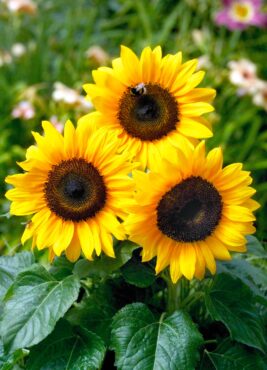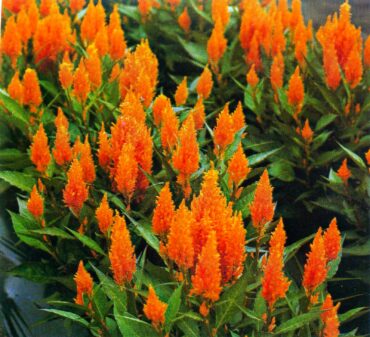
Do you want to make your garden or container plantings really flowery this year?
If so, try adding some easy-to-grow annual seeds to your spring shopping list. Annuals are plants that complete their whole lifecycle in one growing season. You can plant the seeds either directly outside or you can start them inside, in little pots.
Over the course of the next month or so, they will produce a leafy plant that then gets big enough to make flowers. These blooms attract insects or birds to pollinate the flowers so that they set seed. That is the whole life of an annual flower.
Starting Seeds Indoors, Why Not?
Some gardeners are doubtful about starting plants from seeds. My thought is that it’s worth a try. Each seed packet will only cost a few dollars but could have tens, hundreds or even thousands of seeds in it. Even if a few of these little plant babies come up, you will have added beautiful flowers to your garden, and it will be worth it!
If you’re new to seed sowing, I recommend beginning with some of the easiest flower seeds. These are large seeds that can be poked straight into the ground. If you garden where you have a short growing season or where you are super excited and want to start sowing immediately, then you can sow them inside in potting soil in small pots.
What to Know About Growing from Seed
To germinate seeds successfully, you will need a few things.
The first is a moist soil that’s not soaking wet. The water goes into the seed and starts the growing process.
The second is that seeds need some oxygen from the surrounding soil, so the soil should have plenty of natural airspaces.
The third is a certain temperature range for their particular needs. Some seeds will germinate in cool soil, while others need warm soil to begin growing.
Lastly, the seeds may need light or darkness to grow.
Cool vs. Warm Season
Annual flowers are divided into two main groups, according to whether they do best in cool or hot weather.
Cool-season annuals thrive when the soil and the air temperatures are above freezing, but not yet hot. In cool summer climates, these may keep flowering all summer.
Warm-season annuals are only planted at the same time as you would put out tomatoes and other warm-season vegetables. The soil should be at least 60 F. To know when to plant your different annual types, you need to find out approximately when your last frost is predicted. Keep in mind, this is only an expected last frost date.
If you have already sown your seeds and the weather turns cold again, you can always cover up outside beds with an old sheet or tablecloth and remove it when it warms back up. Seeds growing outside in containers can also be covered or moved into a garage or porch.

A Few Tips for Caring for Your Annual Flowers
The first is to pay attention to them as they grow.
Plant them into good soil that has extra organic matter added to it. If you don’t want to mix it in, just add an inch onto the surface around the places where you planted the seeds.
Water the soil before planting the seeds. If you get no rain, check the soil moisture in the next couple of weeks. Do not water again unless the soil is really dry. Too much water causes the seeds to rot.
When the shoot comes up, water gently using a watering can with a multiholed attachment so the spray is soft.
Once the plant is 12-18 inches high, you can nip out the main growing tip to help make the plant bushy and full.
When the flowers are produced, keep picking them for bouquets as well as enjoying them on the plant. Promptly take off finished flowers so that new ones are made.
Another tip to prolong your flowering season is to sow one batch of seeds, then a couple of weeks later, sow another batch. The later seedings will take over once the first ones come to an end. These are annual plants that will stop blooming once they set enough seed.
Unless you have very sandy soil that contains few nutrients, you may not need to add fertilizer to the soil. I grow my plants with as little fertilizer as possible unless they’re in a container — where they cannot get their roots down into regular garden soil.
If you fertilize, it’s best to do it at about half the strength of what the directions say because any excess that the plants don’t use will be washed away into the groundwater. I like fish emulsion or seaweed fertilizers.
If needed, use bamboo sticks to keep your annuals upright — or let them grow next to a fence or other plant support.
10 of My Favorite Annual Flower Seeds
These are all ones that I grow in my garden in Pennsylvania. They’re all good growers over a wide range of temperatures and soil types. Make sure that you plant them in an area that gets at least six hours of full sun a day. Any less than this and the plants may be spindly.
Bachelor’s Buttons (Centaurea)
These seeds don’t like to be transplanted, so sow them straight outside into the garden, in a sunny place, a few weeks before your last frost.
The flowers are blue, pink, white or purple and very slightly scented. The blue is especially desirable because there are only a few truly blue summer flowers. Cornflowers also go by the name of bachelor’s buttons because men used to put them into the buttonhole of their jackets.
Keep deadheading to get as many blooms as possible. These plants will stop flowering when the weather gets hot and humid.
Celosia (Celosia)
Celosia comes in several shapes, from the brain-shaped crested celosia, to the wide-plumed and the narrow-feathery shape.
The colors are vibrant reds, oranges, yellows and pinks. Foliage can be green or crimson. Find out more about celebrating Celosia here.
Sow the seeds inside 4-6 weeks before your last frost or outside after the last frost.
Cosmos (Cosmos)
This is an easy plant to grow from seed, either started inside or sown directly into the garden. The seeds need light to germinate, so sow shallowly.
There are many possible types, from the traditional pink and white to the oranges and yellows of the sulfur cosmos. Choose them by flower color and plant height.
If you garden in a cool-summer area, check how many days this flower takes from seed to bloom and start them inside, if necessary. In any climate, they do their best flowering later in the summer.
Larkspur (Consolida)
This is another wonderful flower to sow directly into the garden because it doesn’t do well if you disturb its roots. Larkspur needs cool soil to germinate and takes a while to come up, so don’t despair.
The flowers are tall and come in the loveliest of blues, some soft pinky-purples and white. Each stem has many little flowers. They make a great cut flower.
They do well in late spring and early summer in hot climates, and will last well into summer in cool climates.
Marigold (Tagetes)
These are the classic summer flowers that have several different forms, from the large mop-head shape to the slender single daisies. Choose them by flower shape, color and height.
If you want them for edging a border, go for the short ones; whereas for cutting, pick ones that have long stems. The narrow, slender seeds are easy to sow directly into the garden and have often been sown alongside vegetables.
Wait until the soil warms up before planting and make a couple of sowings a few weeks apart for continued bloom. They can be sown inside up to six weeks before the last frost.
Nasturtium (Tropaeolum)
Nasturtiums are great old-fashioned plants that produce edible leaves and flowers, as long as you don’t spray anything onto your garden.
The seeds are round and can be sown in places where the rounded leaves come up first. They may flower a little in late spring and will do well in cool summers.
In hot summers, try to keep the plants growing all summer long, and they will flower again in fall. In short summer seasons, start them in paper pots so that they can be planted without disturbing their roots.
The flowers are tubular and come in lovely oranges, reds, yellows, creams and russets. There are some bicolors too.
Look at the type of seed that you are buying. There are those that make clumps, and there are others that make long runners.
Pot marigold (Calendula)
This is also called marigold but is in a different genus. It’s a cool-season annual that thrives in climates with mild summers. In hot summer climates, pot marigold will bloom in spring and autumn.
They’re easy to grow from seed sown directly into the garden as soon as the soil has warmed slightly.
Their flowers are yellow, orange or cream and daisy-shaped or doubled.
Spider flower (Cleome)
Spider flowers love sunny, hot summers. Plant the seed out in the garden once the soil has warmed up, but when the nights are still cool.
They do best for me in my herb garden, in between the paving slabs, where they get warmth and reflected light off the stones. They self-seed into the cracks.
The flowers live up to their name with white, purple or pink flowers that go out in all directions from a tall, rather prickly, stem.
Sunflower (Helianthus)
What would a summer flower garden be like without at least one type of sunflower?
These are simple to sow. Look for a site with good rich soil because if you are growing tall sunflowers, they need a lot of goodness from the soil. Place them in full sun but make sure it’s an area where they will not shade the rest of the garden.
In the Northern Hemisphere, put them on the north edge of your garden. Sow some as soon as the soil has warmed up and frosts are finished. Then, sow some more a few weeks later.
Choose your sunflowers by height, flower color and size. Also consider whether you want pollen for pollinators or if you want one of the new pollen-less ones that are good for arranging but not for bees. Give each seed plenty of room to grow. Learn more about all the types and growing sunflowers here.
Zinnia (Zinnia)
Last, but in my mind, definitely not least, are zinnias. They are my go-to plant for cutting flowers and for adding color to my summer flower garden.
There are so many types and sizes, every flower gardener will find some they like — and they’re also easy to grow from seed. You can plant them into paper pots inside and then plant some more once the soil has warmed up. Think of the time when you put out tomatoes — that is when your zinnias go out.
Good luck with your summer flower garden. I hope that your flowers bring you as much joy as they have to generations of flower gardeners.
This article is provided as an educational/inspirational service of the National Garden Bureau and its members. Founded more than 100 years ago, the National Garden Bureau educates, inspires and motivates people to grow home gardens. NGB members are horticultural experts, and the information shared with you comes directly from these experts to ensure your gardening success.


























Comments